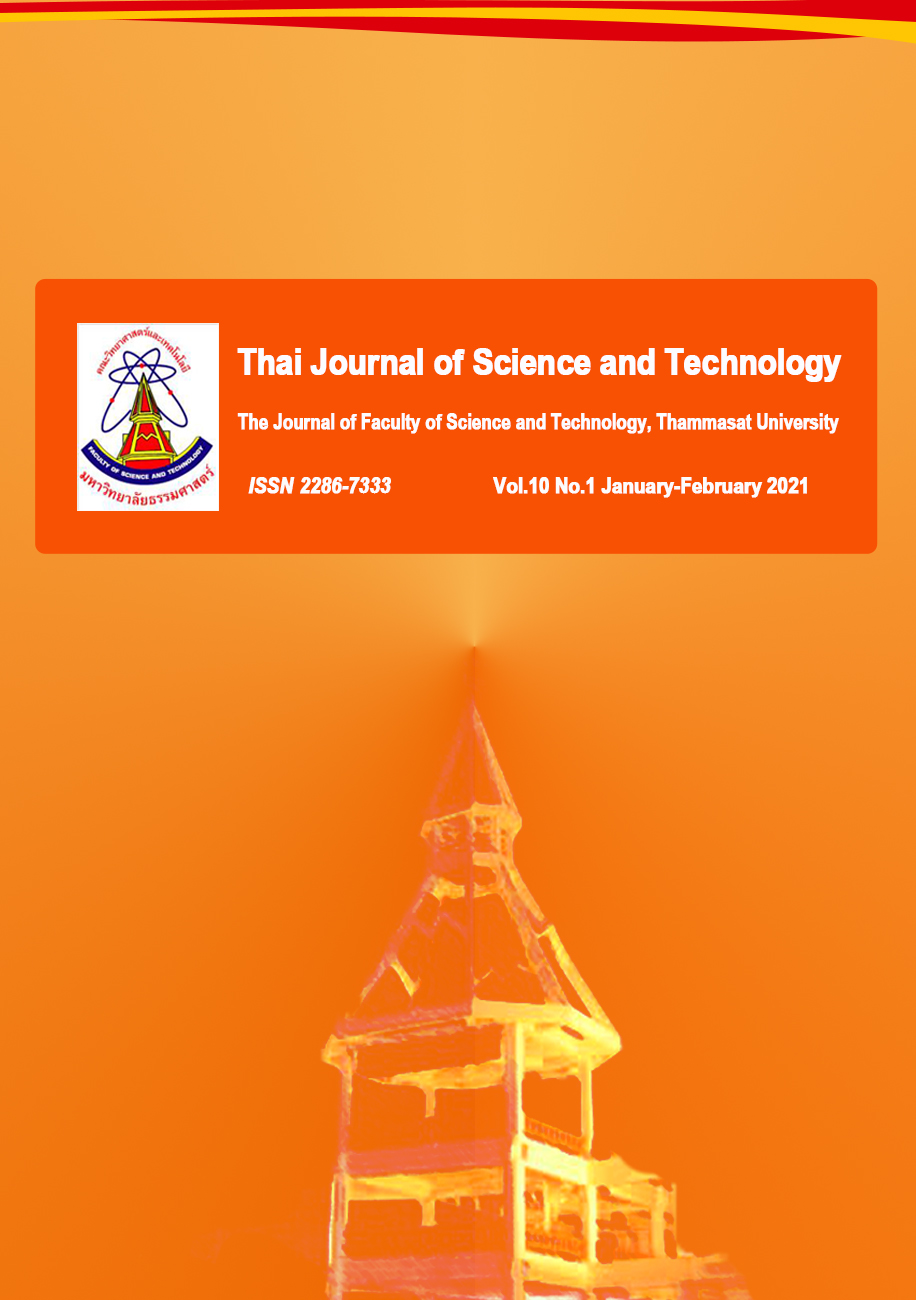Chemical Composition and Optimum Condition of Protein Concentrate Extraction from Commercial Crickets
Main Article Content
Abstract
The objective of this research was to evaluate the chemical composition of 3 cricket types; house cricket (Acheta domesticus), golden cricket (Gryllus testaceus Walker) and giant cricket (Brachytrupes portentosus). The optimum condition for protein concentrate extraction and their isoelectric point (pI) were also studied. Giant cricket (B. portentosus) had the highest protein content of 68.97%. The pI value of proteins from house cricket, golden cricket and giant cricket was 5.5. The protein concentrate extraction was studied using the temperature of 40, 50 and 60 °C for 30, 60 and 90 min. The results found that the highest protein contents from house cricket and giant cricket, extracted at 50 °C for 60 min were 26.77 and 27.00 mg/mL, respectively. The highest protein content from golden cricket extracted was 26.99 mg/mL at the condition of 60 °C for 90 min.
Article Details

This work is licensed under a Creative Commons Attribution-NonCommercial-NoDerivatives 4.0 International License.
บทความที่ได้รับการตีพิมพ์เป็นลิขสิทธิ์ของคณะวิทยาศาสตร์และเทคโนโลยี มหาวิทยาลัยธรรมศาสตร์ ข้อความที่ปรากฏในแต่ละเรื่องของวารสารเล่มนี้เป็นเพียงความเห็นส่วนตัวของผู้เขียน ไม่มีความเกี่ยวข้องกับคณะวิทยาศาสตร์และเทคโนโลยี หรือคณาจารย์ท่านอื่นในมหาวิทยาลัยธรรมศาสตร์ ผู้เขียนต้องยืนยันว่าความรับผิดชอบต่อทุกข้อความที่นำเสนอไว้ในบทความของตน หากมีข้อผิดพลาดหรือความไม่ถูกต้องใด ๆ
References
กัณฑ์วีร์ วิวัฒน์พาณิชย์. (2542). แมลงอาหารมนุษย์ในอนาคต. สถาบันการแพทย์แผนไทย กรมการแพทย์ กระทรวงสาธารณสุข. โรงพิมพ์องค์การสงเคราะห์ทหารผ่านศึก. กรุงเทพมหานคร.
กาญจนา อินทรศิล และสุคนธ์ชื่น ศรีงาม. (2549). สภาวะในการเตรียมวัตถุดิบและการสกัดโปรตีนจากกากธัญชาติจากการผลิตเบียร์. การประชุมทางวิชาการของมหาวิทยาลัยเกษตรศาสตร์ ครั้งที่ 44 : สาขาอุตสาหกรรมเกษตร สาขาเศรษฐศาสตร์ สาขาบริหารธุรกิจ. มหาวิทยาลัยเกษตรศาสตร์.
ทัศนีย์ แจ่มจรรยา. (2555). ความยั่งยืนของธุรกิจแมลงกินได้. แก่นเกษตร. 40(3): 203–206.
นิธิยา รัตนาปนนท์. (2557). เคมีอาหาร. (พิมพ์ครั้งที่ 5). โอเดียนสโตร์: กรุงเทพมหานคร.
วรากร วราอัศวปติ จำนง วิสุทธิแพทย์ และชูเกียรติ มณีธร. (2518). แมลงที่เป็นอาหารในภาคตะวันออกเฉียงเหนือ. เอกสารงานวิจัย ฉบับที่ 7 มหาวิทยาลัยศรีนครินทรวิโรฒมหาสารคาม.
วารยา บุษปธำรง. (2539). เครื่องดื่มโปรตีนไฮโดรไลเซทจากกากถั่ว. วิทยานิพนธ์ปริญญาวิทยาศาสตรมหาบัณฑิต สาขาวิชาเทคโนโลยีทางอาหาร คณะวิทยาศาสตร์ จุฬาลงกรณ์มหาวิทยาลัย.
AOAC. (2007). Official Method of Analysis of AOAC International. 18th edition. AOAC International. Maryland. USA.
Blasquez, J., Pino Moreno, J. M. and Martinez Camacho, V. H. (2012). Could grasshoppers be a nutritive meal. International Journal of Food Science. 3: 164–175.
Chen, X., Feng, Y. and Chen, Z., (2009). Common edible insects and their utilization in China. Entomological Research. 39: 299–303.
Coelho, T. L. S., Braga, F. M. S., Silva, N. M. C., Dantas, C., Junior, C. A. L., de Souda, S. A. A. and Vieira, E. D. (2019). Optimization of the protein extraction method of goat meat using factorial design and response surface methodology. Food Chemistry. 281: 63–70.
Defoliart, G.R. (1992). Insects as Human food. Gene Defoliart discusses some nutritional and economic aspects. Crop protection. 11: 395-399.
Gahukar, R.T. (2011). Entomophagy and human food security. International Journal of Tropical Insect Science. 31(3): 129–144.
Gresiana, F., Marpaung, A., M. and Sutanto, H. (2015). Protein Isolation from Cricket (Gryllus mitratus). Proceedings of the International Conference on Innovation, Entrepreneurship and Technology 25–26 November 2015, BSD City, Indonesia.
Hanboonsong, Y., Rattanapan, A., Waikakul, Y. and Liwavanich, A. (2001). Edible Insect Survey in Northeastern Thailand. Khon Kaen Agriculture Journal. 29(1): 35–44.
Johnson, A.H. and Peterson, M.S. (1974). Encyclopedia of Food Technology and Food Science Series Vol. II: Encyclopedia of food science. The AVI Publishing Company, Inc. Westport. Connecticut.
Kristinson, H. G. and Rasco, B. A. (2000). Fish Protein Hydrolysate Production, Biochemical and Functional Properties. Review in Food Science and Nutrition. 40(1): 43–81.
L’Hocine, L. and Pitre, M. (2016). Quantitative and qualitative optimization of allergen extraction from peanut and selected tree nuts. Part 1. Screening of optimal extraction conditions using a D–optimal experimental design. Food Chemistry. 194: 780–786.
Lee, H.J., Kim, J.H. and Lee, C.H. (2019). Effects of Heating Time and Temperature on Functional Properties of Proteins of Yellow Mealworm Larvae (Tenebrio molitor L.). Food Science of Animal Resources. 39(2): 296–308.
Ndiritu, A. (2017). Physical, Chemical and Functional Characterization of Edible Cricket (Acheta domesticus) Protein Concentrate. A thesis submitted in partial fulfilment for the degree of Master of Science in Food Science and Nutrition in the Jomo Kenyatta University of Agriculture and Technology. Kenya.
Panyam, D. and Kilara, A. (1996). Enhancing the functionality of food proteins by enzymatic modification. Trends Food Science and Technology. 7: 120–125.
Phillips, J., and Burkholder, W. (1984). Allergies related to food insect production and consumption. Food Insects Newsl. 8: 1–2.
Van Huis, A. (2013). Potential of Insects as Food and Feed in Assuring Food Security. The Annual Review of Entomology. 58(1): 563–83.
Yhoung–Aree, J. and Viwatpanich, K. (2005). Edible insects in the Lao PDR, Myanmar, Thailand and Vietnam. In M.G. Paoletti, ed. Ecological implications of mini–livestock. Potential of insects, rodents, frogs and snails, pp. 415–440. Enfield, New Hampshire, Science Publisher, Inc.
Young, V.R. and Pallet, P. L. (1994). Plant proteins in relation to human protein and amino acid nutrition. American Journal of Clinical Nutrition. 59: 1203–1212.
Yu, J., Ahmedna, M., and Goktepe, I. (2007). Peanut protein concentrate: Production and functional properties as affected by processing. Food Chemistry. 103: 121–129.


